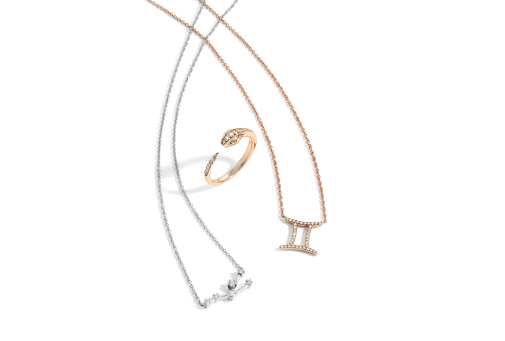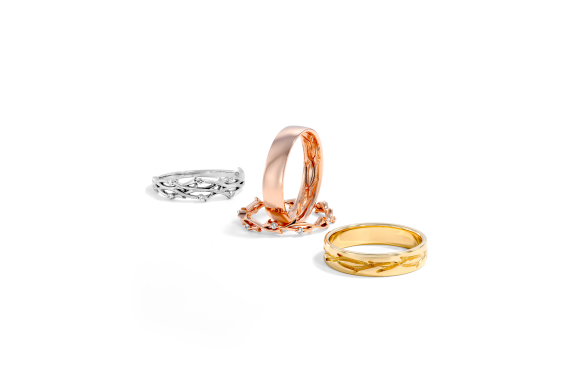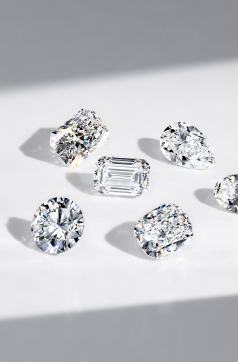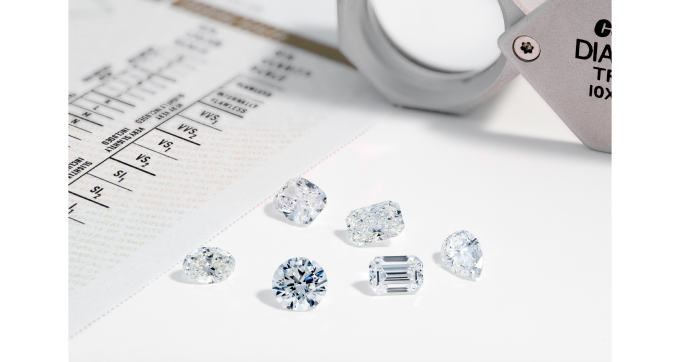When you’re shopping for a diamond, you’re going to come across two forms: natural and lab-grown. They share the same stunning brilliance, identical hardness, and the exact atomic structure, so to the eye and touch, they’re indistinguishable. But beyond their sparkle, the differences are significant. It’s not just about origin: it’s about cost, sustainability, long-term value, and the values behind your choice.
For decades, a few major companies have controlled the supply of natural diamonds, keeping prices high. Lab-created diamonds, on the other hand, are produced by multiple manufacturers, fostering competition and making them more accessible and affordable. In this guide, we’ll explore how lab diamonds are made, how they compare to natural diamonds, and why they’re a smart and sustainable choice for your engagement ring.
Are Lab-Created Diamonds Real?
Lab-created diamonds are chemically, physically, and visually identical to natural diamonds—right down to their atomic structure. The only difference is how they’re made, a process that not only makes them more affordable but also a more sustainable choice. To distinguish between the two, you’d need professional-grade equipment, so if you're worried that someone will spot the difference, don’t be. The only thing anyone will notice is the stunning, larger diamond sparkling on your finger.
Lab-Grown vs. Natural Diamonds
Choosing between lab-grown and natural diamonds comes down to more than just appearance, as they’re identical in brilliance, hardness, and composition. The real difference lies in how they’re formed, their pricing, and what each option represents for you.
Origins
Lab-created diamonds are grown in just weeks under ethical working conditions, ensuring fair wages and sustainable sourcing. Natural diamonds, on the other hand, require mining: a process that causes lasting environmental damage despite efforts toward carbon neutrality.
Beyond environmental impact, ethical concerns remain. The Kimberley Process, introduced in 2003 to reduce the trade of conflict diamonds, has helped but isn’t a perfect solution. That’s why at Keyzar, we take every step to ensure our diamonds are conflict-free: a promise that comes naturally with lab-grown options. To guarantee quality and authenticity, all of our lab and natural diamonds are certified by the Gemological Institute of America (GIA) and the International Gemological Institute (IGI), so you can choose with confidence.
Price
The price of lab-grown diamonds is directly tied to their production, making them more affordable while offering greater value. Since they’re continually manufactured to meet demand, there are no supply shortages or artificially inflated prices. Natural diamonds, on the other hand, come at a premium: not because they’re rare, but because large retailers control supply. For decades, a handful of companies have stockpiled billions of dollars’ worth of diamonds, creating an illusion of scarcity to keep prices high.
Some argue that natural diamonds hold better resale value, but this is often overstated. Most people don’t buy engagement rings as an investment: they buy them as a symbol of love. If resale is a concern, keep in mind that even natural diamonds typically resell for only 30–50% of their original price. A standard diamond purchase rarely retains enough value to make resale worthwhile. If the goal is to maximize beauty for your budget, why not invest in a bigger, more brilliant lab-grown diamond from the start?
With lab diamonds, you get more for your money: a larger, brighter, and equally stunning stone without the inflated cost. In the end, it’s the same diamond, just without the markup. Explore our diamond collection and see the difference for yourself.
Let's Get Technical
Diamonds may be forever, but how they’re formed is where things get interesting. Whether created deep within the earth or in a high-tech lab, every diamond starts the same way - with carbon atoms coming together under extreme conditions to form something breathtaking. Let’s break down how nature and science each craft these incredible gems.
Natural Earth Mined Diamonds
Billions of years ago intense heat and pressure crushed pure carbon into dazzling crystal structures. These prehistoric gemstones remained hidden in the earth until one day, a volcanic eruption sent them to the surface. For centuries, diamonds were found in riverbeds, but eventually, mining operations began unearthing stones that had been waiting millennia to be worn, admired, and cherished.
High Pressure-High Temperature (HPHT)
HPHT diamonds form under the same intense heat and pressure as natural ones—just in a lab and in a fraction of the time. A tiny diamond seed is placed in a specialized chamber, where temperatures exceed 2,000°F and pressures reach 1.5 million pounds per square inch. Under these conditions, carbon melts and crystallizes around the seed, growing into a pure, stunning diamond that's chemically and visually identical to those formed underground for billions of years.
Chemical Vapor Deposition (CVD)
Now, imagine growing a diamond the way snowflakes form: tiny carbon atoms bonding layer by layer onto a crystal base. That’s essentially how CVD diamonds are made, but instead of a winter storm, this process takes place in a controlled, high-tech lab. A small diamond seed is placed in a vacuum chamber filled with carbon-rich gas. When heated, the gas breaks apart, releasing pure carbon that settles onto the seed, forming a diamond.
Whether a diamond is mined, HPHT-grown, or CVD-created, once it’s cut, the only way to tell the difference is through professional certification. So whether you love the idea of a diamond forged deep within the earth or one crafted with cutting-edge technology, every diamond tells a story. The only question is: which one will be yours?
Frequently Asked Questions
Do Lab-Grown Diamonds Hold Their Value?
Lab-grown diamonds, like natural diamonds, typically depreciate after purchase. But natural diamonds are subject to supply control by large mining companies, while lab diamonds are readily available and mass-produced, which may impact their long-term value. However, if you’re buying a diamond for its sentimental value rather than investment potential, a lab-grown diamond remains a beautiful, high-quality choice at a fraction of the price.
Are Lab-Grown Diamonds More Ethical?
Lab-grown diamonds eliminate concerns about conflict diamonds and typically require fewer resources compared to traditional mining. However, lab diamond production is energy-intensive, and not all manufacturers use sustainable or renewable energy sources. If ethical sourcing is a priority, look for brands like Keyzar, which are committed to carbon-neutral production.
Do Lab-Grown Diamonds Get Cloudy?
No, lab-grown diamonds do not get cloudy over time. However, they can accumulate dirt, oil, and residue, which may dull their sparkle. Regular cleaning with a gentle jewelry cleaner or mild soap and water keep them looking as brilliant as the day you bought them.
What are the Downsides of Lab-Grown Diamonds?
While lab-grown diamonds are sustainable and affordable, they do have some minor drawbacks. Their resale value is lower due to increasing production and market supply. Some buyers also value the rarity and natural formation process of mined diamonds. However, if you prioritize cost savings and ethical sourcing, lab-grown diamonds remain an excellent alternative for engagement rings and fine jewelry.
Conclusion
Lab-created diamonds offer the same brilliance as natural ones: just without the billion-year wait or the premium price tag. With a lab diamond, you can choose a larger, high-quality stone while saving thousands. That means more sparkle without compromise.
Why settle? Invest in a stunning diamond and put your savings toward something meaningful. Explore our collection of lab diamond engagement rings today!






